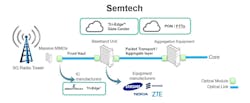What you’ll learn:
- What optical technology leads the way for wireless networks?
- The attributes of optical fiber
- Introduction to Semtech’s Tri-Edge technology
There’s one trend everyone in the telecom industry agrees upon—the exponential growth in connected devices and data traffic per device. To handle that, carriers and infrastructure providers require a strong foundation to transmit data to networks and effectively bring services to users. Without a solid network, 5G simply can’t succeed.
This network foundation starts with optical technology. Optical fiber technology is often overlooked as the key to making fast and reliable 5G a reality. Yet, it’s already playing a crucial role in delivering the high-bandwidth and low-latency requirements needed to support 5G, 5.5G, 6G, and beyond.
Fiber is inexpensive, fast, can handle large amounts of data, and manage it all over longer distances. As we move to support new technologies, fiber will remain the medium of choice. The challenge comes in increasing the amount of data we’re able to transfer over it efficiently.
Optical Tech Leveraged in Today’s Wireless Networks
Wireless networks need a foundation to support and transfer the increasing data between connected devices and new use cases. Part of that foundation is optical fiber. Fiber has become the main way to move data because it’s cost-effective and can transmit substantial amounts of data over longer distances.
However, to make sure data is understood and correctly transferred from point A to point B, the network needs technology to convert between electrical and light signals without losing or misrepresenting data. In other words, it must accurately communicate information from one end of the fiber to the other so that videos stream without freezing and calls carry on without dropping.
Changes Loom for Future Wireless Networks
Future wireless networks will integrate optical technology to become more adaptable and scalable to meet increasing data needs within existing infrastructure. For example, Semtech’s optical networking platform, for example, provides a backbone IC technology to support such higher rates and global data usage.
For instance, Tri-Edge CDR ICs, the GN2255 and GN2256, enable near-zero latency variation and a more than 20% power reduction compared to digital signal processor (DSP) technology. They can also double the bandwidth of currently deployed 25-Gb/s non-return-to-zero (NRZ) front-haul links. Integrating Tri-Edge into localized data centers at the edge of networks helps wireless networks increase processing power closer to the consumers to improve performance and avoid delays.
Optical technology will also make future wireless networks more sustainable. Analyst firm ABI Research reports that while 5G is 90% more efficient than 4G in terms of energy consumption per unit of traffic, 5G base stations require 3X more energy to provide the same coverage as a 4G network.
Semtech estimates that optical ICs like those within the Tri-Edge family could save up to 1 TWh of energy and 384,000 metric tons of CO2 emissions from data-center and wireless-system optical links each year. This is the energy equivalent of powering 100,000 homes. Integrating power-saving optical technology will make the digital transformation age more sustainable.
Use Cases Supported by Wireless-Network Optical Tech
Optical technology opens a world of connected use cases across industries. Because optical technology will allow wireless networks to handle increased data transfer with less power and cost, we’ll see movement in exciting use cases like remote surgeries, autonomous cars, smart cities, AI, and more.
For example, robotic telesurgery could provide extreme and urgent healthcare services and deliver highly specialized skills globally, but it depends on network performance, especially latency.
What Does the Future Hold for 5G, 5.5G and 6G?
5G is at an interesting inflection point. Consumers expect carriers to make good on the 5G promise, while carriers and infrastructure providers face upgrade challenges before they can even begin fulfilling new use cases.
On that front, Semtech is helping customers adopt Tri-Edge technology so that the foundation is in place for next-gen networks today. The company is also working with the industry ecosystem to reimagine what the next 15 years of wireless infrastructure strategy and innovation will look like.

